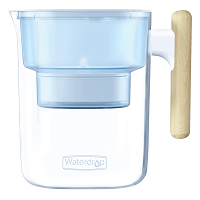Tap water is often taken for granted, even though it is so important. You probably do not think twice about putting it in your dog’s bowl every morning. But is tap water really safe for your pet?
Dr. Ann Hohenhaus, a veterinarian at Animal Medical Center in New York City, says that in the vast majority of cases, it is. But as the water crisis in Flint, Michigan, has shown, not all tap water is safe. “If you would not drink that water, you should not feed it to your dogs,” Hohenhaus says.
Is It Safe to Give Your Dog Tap Water?
According to the findings, dogs do not develop bladder cancer from drinking tap water.
Long-term exposure to disinfected tap water – the water that comes out of our taps after being treated with chemicals like chlorine – has been linked to bladder cancer in humans.
However, no such link was found in dogs in the study led by Dr. Lorraine Backer of the Centers for Disease Control and Prevention.
There could be several reasons why dogs who drink tap water do not seem to have an increased risk of bladder cancer, although humans do.
For starters, a dog’s exposure to disinfection byproducts – chemicals created when things like chlorine interact with natural organics – is different than that of its human owners.
Dogs do not drink a big glass of water the same way humans do.
What You Can Do to Ensure Your Water Is Safe to Drink?
Follow these tips from Pauli Undesser, executive director of the Water Quality Association (WQA), to determine if your tap water is safe for you and your pet:
1. Contact your water treatment plant for a consumer confidence report.
According to Undesser, the majority of customers get their water from the city. The water is treated in a treatment plant before it can flow from the tap. To give you an idea of what’s in your water, this plant is required to publish an annual consumer confidence report. (Contact your water supplier if you have not received one)./div>
“Maybe there are things that the water treatment plant knows about and is working on, but you still might want to do something different,” Undesser says.
The federal government regulates water treatment plants, but individual states may have stricter rules. California, for example, has passed a law limiting the amount of chromium-6 in drinking water. (If that sounds familiar, that’s because it’s the pollutant Erin Brockovich campaigned against).
2. Check the quality of the water in your home.
Since hard contaminants cannot be seen or smelled, Undesser recommends that consumers test their tap water once a year. “Tap water testing is still something consumers should do to be aware of what might be in their water,” Undesser says. “You just never know until you test.”
If consumers notice sudden changes in odor, taste, or color, they should have their water tested.
While you can buy a water testing kit and mail it to a lab, Undesser recommends sending your water to one of the EPA –approved labs for water testing. She adds that some city departments and health departments test water for free.
Is It Safe for Dogs to Drink Filtered Water?
Most health experts agree that drinking filtered water is safe for dogs, and in some areas experts advise against dogs drinking unfiltered water. According to the American Society for the Prevention of Cruelty to Animals, unfiltered water can contain:
- Reducing agents are substances that help reduce water turbidity.
- Toxic chemicals in chemicals can cause vomiting, diarrhea, bloody stools, hypocalcemia (low calcium), and hypoglycemia (low blood sugar)
- Toxic chemicals in chemicals can cause vomiting, diarrhea, bloody stools, hypocalcemia (low calcium), and hypoglycemia (low blood sugar) (low blood sugar). Dogs can be poisoned by natural chemicals.
Is it possible to filter your own tap water at home? Do you use a water filter pitcher like the Waterdrop? Because it has a 5-stage filter, the plump water filter pitcher produces better results than most filters that only have two stages. Waterdrop’s patented technology allows you to save money on bottled water while guaranteeing the purity of your tap water.
In short, your pet should be able to drink the same water you do, whether it comes from the tap, filtered, or elsewhere. We recommend catering to his preferences if he does not like the taste or seems to have one. Reduced water intake has been shown to negatively impact health, especially kidney health, while changing water sources has not been shown to significantly impact healthy pets.

